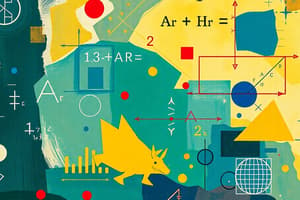Podcast
Questions and Answers
What is the correct order of operations when simplifying the expression $3 + 2 \times (8 - 3)$?
What is the correct order of operations when simplifying the expression $3 + 2 \times (8 - 3)$?
- $5 + 6$
- $13$ (correct)
- $18$
- $15$
Which of the following is NOT a property of a right triangle?
Which of the following is NOT a property of a right triangle?
- The sides follow the Pythagorean theorem
- All sides are equal in length (correct)
- The sum of the angles is 180 degrees
- One angle measures 90 degrees
What is the value of the discriminant in the quadratic equation $2x^2 - 4x + 2 = 0$?
What is the value of the discriminant in the quadratic equation $2x^2 - 4x + 2 = 0$?
- $2$
- $4$
- $0$ (correct)
- $-8$
Which trigonometric identity represents the relationship between sine and cosine?
Which trigonometric identity represents the relationship between sine and cosine?
What is the area of a triangle with a base of 10 units and a height of 5 units?
What is the area of a triangle with a base of 10 units and a height of 5 units?
In statistics, what measure indicates the middle value of a data set when arranged in ascending order?
In statistics, what measure indicates the middle value of a data set when arranged in ascending order?
What is the fundamental theorem of calculus primarily about?
What is the fundamental theorem of calculus primarily about?
Which of the following best describes a permutation?
Which of the following best describes a permutation?
Flashcards are hidden until you start studying
Study Notes
Key Areas of Mathematics
1. Arithmetic
- Basic operations: addition, subtraction, multiplication, division
- Properties of numbers: whole numbers, integers, rational, and irrational numbers
- Order of operations: PEMDAS/BODMAS (Parentheses, Exponents, Multiplication and Division, Addition and Subtraction)
2. Algebra
- Variables and expressions: understanding symbols that represent numbers
- Equations and inequalities: solving for unknowns
- Functions: linear, quadratic, polynomial, exponential
- Factorization: finding the roots of equations
3. Geometry
- Fundamental shapes: triangles, circles, squares, rectangles
- Concepts: area, perimeter, volume
- Theorems: Pythagorean theorem, properties of angles (complementary, supplementary)
- Coordinate geometry: points, lines, and slopes on the Cartesian plane
4. Trigonometry
- Basic functions: sine, cosine, tangent and their reciprocals (cosecant, secant, cotangent)
- Right-angled triangles: relationships between sides and angles
- Trigonometric identities: sin²θ + cos²θ = 1
5. Calculus
- Limits: understanding behavior of functions as they approach specific points
- Derivatives: concepts of rates of change and slopes of tangents
- Integrals: area under curves and accumulation functions
- Fundamental theorem of calculus: links differentiation and integration
6. Statistics & Probability
- Descriptive statistics: mean, median, mode, range, variance, standard deviation
- Probability concepts: events, outcomes, independent vs. dependent events
- Distributions: normal distribution, binomial distribution, Poisson distribution
7. Discrete Mathematics
- Set theory: unions, intersections, and complements of sets
- Graph theory: paths, cycles, vertices, and edges
- Combinatorics: counting principles, permutations, combinations
8. Mathematical Reasoning
- Logical statements: implications, equivalences, and quantifiers
- Proof techniques: direct proof, contradiction, induction
- Problem-solving strategies: working backwards, using symmetry, making a model
Useful Formulas
- Area of a triangle: A = 1/2 * base * height
- Quadratic formula: x = (-b ± √(b² - 4ac)) / (2a)
- Slope of a line: m = (y2 - y1) / (x2 - x1)
- Interest formula (simple): I = P * r * t
Study Tips
- Practice solving problems to reinforce concepts.
- Use visual aids (graphs, shapes) for geometry and calculus.
- Memorize key formulas and understand their applications.
- Work on sample problems in different areas to build versatility.
- Review and summarize each concept regularly to retain information.
Arithmetic
- Basic arithmetic operations are addition, subtraction, multiplication, and division.
- Number systems include whole numbers, integers, rational numbers (fractions and decimals), and irrational numbers (cannot be expressed as fractions).
- Order of Operations is PEMDAS/BODMAS: Parentheses (Brackets), Exponents (Orders), Multiplication and Division (from left to right), Addition and Subtraction (from left to right).
Algebra
- Focuses on solving for unknowns using variables and expressions.
- Linear equations and inequalities are the building blocks of algebra, involving variables with powers of 1.
- Functions are relationships between variables, represented by equations. Types include linear, quadratic (power of 2), polynomial (multiple powers), and exponential (variable as exponent).
- Factorization breaks down expressions into simpler factors, helping solve for unknowns when equations are set to zero.
Geometry
- Explores shapes like triangles, squares, circles, and rectangles.
- Fundamental concepts include area (amount of surface), perimeter (total length of sides), and volume (space occupied by a 3D shape).
- Key theorems include the Pythagorean Theorem (relates sides of a right triangle) and properties of angles (complementary - add up to 90 degrees, supplementary - add up to 180 degrees).
- Coordinate geometry uses the Cartesian plane (x-y axes) to analyze points, lines, and slopes.
Trigonometry
- Studies the relationships between angles and sides of triangles, using trigonometric functions like sine, cosine, tangent, and their reciprocals.
- Focuses on right-angled triangles, applying trigonometric functions like sine, cosine, and tangent to calculate angles and sides.
- Trigonometric identities, like sin²θ + cos²θ = 1, are true for any angle θ.
Calculus
- Deals with rates of change and areas under curves.
- Limits help understand the behavior of functions as they approach specific points.
- Derivatives represent the rate of change of a function at a particular point, often visualized as the slope of a tangent line.
- Integrals represent the area under a curve, providing information about accumulation or total change.
- The Fundamental Theorem of Calculus connects differentiation and integration, serving as a central principle for solving many calculus problems.
Statistics & Probability
- Deals with analyzing data and understanding the likelihood of events.
- Descriptive statistics summarizes data through measures like mean (average), median (middle value), mode (most frequent value), range (difference between highest and lowest), variance (spread of data around the mean), and standard deviation.
- Probability studies the chances of events happening, considering outcomes, independent/dependent events, and various probability distributions like the normal distribution, binomial distribution (used for discrete events), and Poisson distribution (for rare events occurring over time).
Discrete Mathematics
- Focuses on finite and countable objects, analyzing relationships between these objects.
- Set theory involves manipulating sets, understanding unions (elements in both), intersections (elements in common), and complements (elements not included).
- Graph theory explores the connections between objects (vertices) using lines (edges), studying paths, cycles, and other properties.
- Combinatorics focuses on counting problems, utilizing principles like permutations (arranging objects in a specific order) and combinations (selecting objects without order).
Mathematical Reasoning
- Emphasizes logical thinking and proofs.
- Logical statements involve implications (if-then), equivalences (two statements are equivalent), and quantifiers (for all, there exists).
- Proof techniques include direct proof (show conclusion follows directly from assumptions), contradiction (assume the negative of the conclusion and deduce a contradiction), and induction (prove a base case and then show that if the statement is true for one case, it's also true for the next).
- Problem-solving strategies involve working backwards, using symmetry, creating models, and breaking down complex problems into smaller ones.
Useful Formulas
- Area of a triangle: A = 1/2 * base * height
- Quadratic formula: x = (-b ± √(b² - 4ac)) / (2a), solves quadratic equations of the form ax² + bx + c = 0.
- Slope of a line: m = (y2 - y1) / (x2 - x1), represents the steepness of the line.
- Simple Interest formula: I = P * r * t, calculates the interest earned on a principal amount (P) at a rate (r) over a period of time (t).
Study Tips
- Practice solving problems to solidify understanding.
- Use visual aids like graphs, diagrams, and shapes for geometry and calculus concepts.
- Memorize key formulas and practice applying them in different contexts.
- Work on sample problems from various areas to build versatility.
- Review and summarize concepts regularly to retain information.
Studying That Suits You
Use AI to generate personalized quizzes and flashcards to suit your learning preferences.




